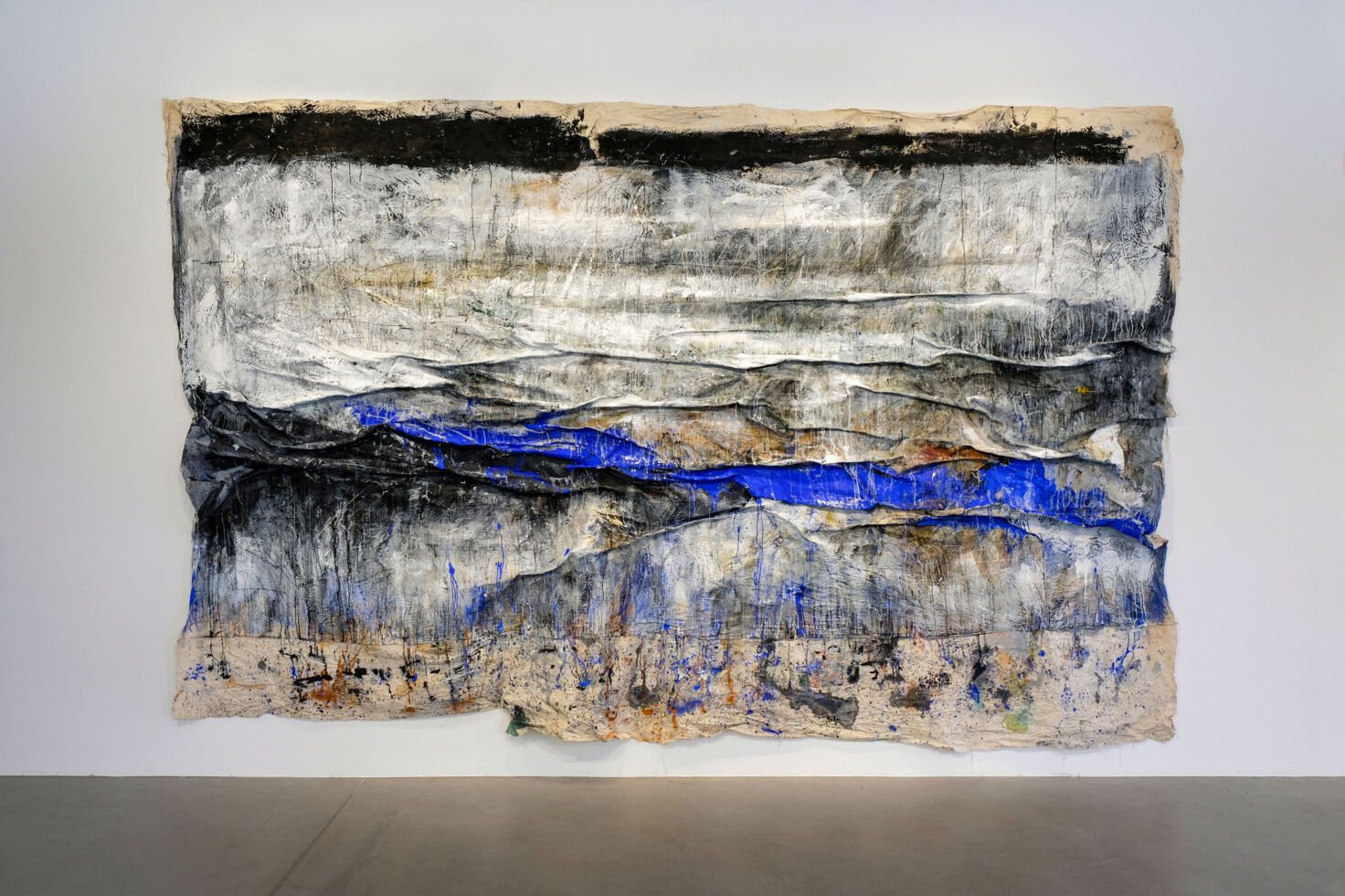
The earth tastes different wherever you go
One of Jakob Kirchmayr’s new pieces contains the painted words “Längs der Grenze des Seins” (along the edge of existence), which the artist borrowed from a German translation of the poem Stenarna (stones) by Swedish poet and Nobel Laureate Tomas Tranströmer. The painting depicts ice crusts, a frozen dark ground, and a yellow sky from which stones fall. The colors, ambiance, and light convey the feeling of a Northern European environment like the ones often found in Tranströmer’s poems. In this painted landscape, the stones, which in Stenarna stand for human actions, fall to a ground that to the poet symbolized mankind itself.
In his new works, Kirchmayr completely turns his back to the cast of characters he had previously so diligently assembled. He abandons the interior space and sets out on an exploration of vast visual spaces and landscapes. Kirchmayr doesn’t rely on extant motifs, he instead bases his subjects on imaginations from his own memories and experiences or translations of poetry into visual language.
In addition to Tomas Tranströmer, Kirchmayr draws inspiration from two other great 20th century lyricists: Polish Nobel Laureate Wisława Szymborska and Greek poet Yiannis Ritsos. The text fragments the artist uses in his works stem from one of these three poets. He subtly weaves words or sentences into his compositions, never mixing poems, and never drawing from more than one poem per piece. That being the case, he refrains from using poems as mere motifs. Kirchmayr paints and draws his way into the texts, while at the same time translating lines of verse into images. In the end, the works that result from this balancing act fuse together with the cores of the lyrical texts. The text fragments that surface from this process are distillates of deeper explorations into topics that are inherent within the verses relevant to Kirchmayr, which he sometimes reveals in the form of sentences, and other times only hints at with individual words. In many cases, he entirely forgoes any sort of textual layer and focuses entirely on the visual image.
Kirchmayr paints on enormous wrinkled unstretched cotton canvases that he washes and sews together in certain places. In doing so, these surfaces take on the appearance of relief maps—an effect heightened by Kirchmayr’s thick application of paint. For example, a landscape that the artist has created using multiple layers of painted and drawn black and blue surfaces transforms into a Northern European mountain chain. The two-dimensional layers rise up from the surface of the painting and take on a sculptural quality. A similar effect occurs with his paper works, which when treated buckle, become flexible, and gradually harden into spatial objects. The resulting works dispense with the usual borders of presentation and offer a perspective into a space that far exceeds the confines of the picture, further than the depicted image initially reveals. Kirchmayr places his vanishing lines so that they extend out from the edge of his pictures.
Like Wisława Szymborska’s poems, which often appear to be taken from everyday life but contain philosophical issues or larger historical dimensions as well as her own life experiences of the Soviet Union and the post-communist era, Kirchmayr’s works read like multi-layered compositions. In transforming fragments of poems—which in themselves already represent text forms that are condensed, abstracted, and reduced to their essence—into pictures, he enriches them with his own as well as other people’s experiences. In doing so, his landscapes are always surfaces permeated by people and their actions that represent metaphorical conditions, as well as the changes and geographic locations of individuals.
When Kirchmayr invokes Yiannis Ritsos’ poetry, he blends his own childhood experiences in Greece with the atmosphere he encounters in his studio when he reads the poems that inspire him for their tonality and descriptions of landscapes. They are memories of happy family vacations and extended recurring trips to Greece in which the family lived in simple conditions and felt inspired by a different world view. From the perspective of an adult artist, they also represent historical observations of the changes of Greece’s socio-political conditions, which not long ago thrust the country into the economic and political spotlight. Yiannis Ritsos in turn, experienced an entirely different Greece. He was a pacifist, leftist, member of the avant-garde and chronicler of the resistance to the National Socialist occupation, and persecuted during the Greek military junta of 1967 – 1974.
The synthesis of Kirchmayr’s own experiences with those Ritsos experienced and conveyed in his poetry, is expressed in the artist’s landscapes that embody modern Greek history from its bloody battles to peaceful vacations: red earth, dry branches, light-blue horizons. The landscape preserves and perseveres.
In his exploration of Yiannis Ritsos, Wisława Szymborska, and Tomas Tranströmer, Kirchmayr spans a broad conceptual arc from Southern to Northern Europe. These three poets don’t only differentiate themselves from one another by their poetological and conceptual directions. Although they lived under different conditions, they all represent the dynamic and world-changing 20th century: Tranströmer as a poet in a democratic country who had a job and lived comfortably; Szymborska as an author in a communist country, who was soon disillusioned by her initial ideological convictions, causing her to experience a change of heart; and Ritsos as a fierce resistance poet and persecuted artist. Kirchmayr captures these differences in his painted landscapes that reveal a world in a state of flux, and establishes the origins of today’s polarizing climate in the many upheavals of the 20th century.
Kirchmayr doesn’t just use landscapes as metaphors for and projections of his own experiences, his various topographies are portraits of collective memories that evoke an emotional response in the viewer. The earth tastes different wherever you go.